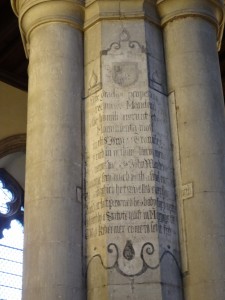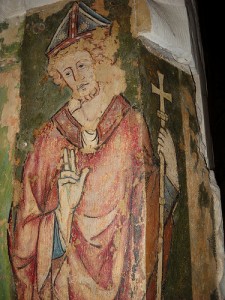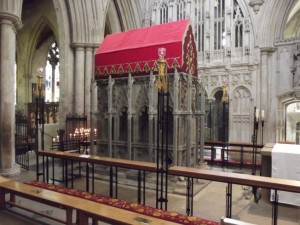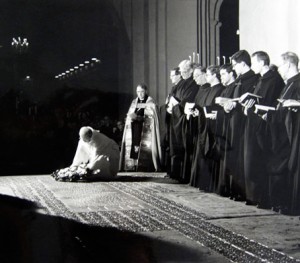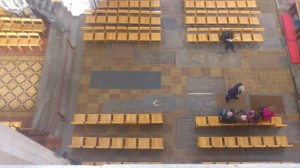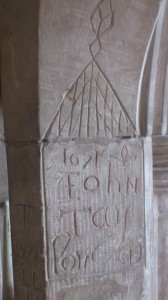Six members of the research team visited St Albans on 16 April 2013, going on to explore the landscape around Runnymede on the following day. The following is a co-authored reflection on the visit and on St Alban’s Cathedral as a site of memory, in the past and in the present. A post on the Runnymede visit will follow soon.
Alban and Origins
The modern name of the town itself testifies to the importance of Alban’s cult and his church to the community which grew up around them. Clearly the relationship was strong at the time of the Dissolution for the townspeople seem to have gone to some trouble to keep the abbey church. The variety of the connections between the church and the communities of church, town, county, kingdom and wider medieval Christendom are intriguing, provoking thought about the ways those connections were made and remembered.
Though attempts to fix the date of his martyrdom range from the early third to the early fourth century, Alban is traditionally regarded as the first Christian to die for his faith in these islands. Whilst it was not until the refoundation of the Abbey in the late 10th century that Alban was declared to be protomartyr Anglorum (the soubriquet by which he came to be known from the central Middle Age onwards), the origins of a wider context for his cult can be discerned much earlier. References in both the Vita Sancti Germani passio preserved in manuscripts in Turin and Paris offer important clues to the possibility that his tomb was already a site of more than local pilgrimage and significance. It was Gildas who first localised Alban, identifying him as “a man of Verulamium” (Verolamiensis); but it has also been argued plausibly that his depiction of Alban crossing the Thames—as opposed to the more obvious but insignificant river Ver—on the way to his martyrdom may have been a deliberate choice, positioning his cult in a regional or even a national context.[1]
The Roman legacy is clearly visible in the fabric of the church today. But the connection with the Roman city was one perpetuated each year through text from at least the ninth century onwards. On 22nd June different religious communities, following different rules, met in chapter across medieval western Christendom after the office of Prime; as they did every day they listened to the reading from the martyrology entry, reminding them of the saints to be remembered the coming day. St Alban entered the martyrological tradition early and the brief two sentences found in most martyrologies from the ninth century onwards recorded how St Alban was martyred in Verulamium in the time of Diocletian. Long after the town had moved up the hill to around the church, the Roman buildings of the old city abandoned and merely raided for masonry, and the new settlement had adopted the name of its ecclesiastical patron, its old Roman name lived on in the minds of professional religious. What did that mean for people listening to the story and the names in it? At what point did Verulamium cease to be a source of building materials and become forgotten in other contexts?
In the twelfth century (c. 1178), William of St Albans produced his Latin ‘translation’ of an eye-witness account of the life and martyrdom of St Alban. This account draws attention to the fact that St Alban, as protomartyr, was himself a convert to Christianity. In the first half of the thirteenth century, Matthew Paris wrote his translation into French, the Vie de Saint Auban. Though largely a translation of William’s work, Matthew Paris claims to be translating a much earlier (early eleventh century) Latin text, which is in turn said to have been a translation of a text in the British language recovered from the ruins of Verulamium. Matthew causes his eye-witness narrator to prophesy the translation of his story into French. The narrator also identifies himself explicitly as a Saracen (whereas in William’s text he is identified simply as a heathen and a pagan).
Jo ki a ceu tens estoie miscreant Sarrazin
De ceste estoire vi le cumençail e fin.
…
La geste ai, cum la vi, escrit en parchemin.
Uncore vendra le jur, ben le di e devin,
La estoire ert translatee en franceis e latin.
Ne sai autre language fors le mien barbarin,
Mais fei ke doi porter lui ki fist d’ewe vin,
Ne I dese fauseté pur tut l’or Costentin.
I, who was at that time a Saracen of false belief, saw the beginning and end of this story….The day will yet come, I say and indeed predict, when the story will be translated into French and Latin. I know no other language than my own barbarian one, but by the faith that I owe to him who made wine from water, may I not have uttered a falsehood for all the gold of Constantine. [2]
Here the transformative powers of translation are associated with Christ’s miraculous transformation of water into wine. And the prophecies of a Saracen powerfully substantiate the claims of a Christian institution about its origins.
By the end of the thirteenth century, then, the Saracen Other could be seen not only as a distant present threat, but as part of St Albans’ own pagan past. This may shed some light on one of the more remarkable burials in the medieval Abbey. In 1872, while excavating the floor before the altar of St Mary of the Four Tapers in the ante-chapel of the Lady Chapel, a cylindrical hole was found in a stone. Within it, a fragile wooden box was found on which lettering identified as Arabic inscribed the name of God. [3] This box, possibly originating from as far away in time and space as tenth century Afghanistan (though this is still uncertain), turns out to be the heart box of Abbot Roger de Norton (d.1290).[4] The burial of a ‘Saracen’ box in almost the same earth as that from which the Saracen account of the martyrdom of St Alban emerged might suggest a kind of reparation or reciprocity, so that the heart could be seen to replace the story of origins which had been removed.
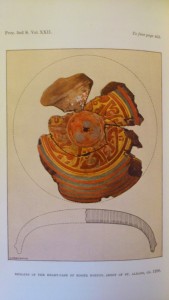
William Page, ‘Notes on the Heart-Case of Roger Norton’, Proceedings of the Society of Antiquaries, 2nd S, Vol XXII, April 1st, 1909: pp.253-4.
Though heart burial was not uncommon for the secular elite, it was less common for clergy. It is even rarer to find heart burials carried out within a few metres of the rest of the body. It hardly seems worth the expense and the sacrifice of bodily integrity to bury different parts of the body so close together. Roger de Norton is the only Abbot to have been buried in this way at St Alban’s.
The divided burial negotiates the claims of the individual and the community: as an abbot, de Norton’s body was buried in the choir with all the other abbots of St Albans. Yet his heart was placed in a hole in the stone before the altar of the Virgin Mary, in the eastern part of the church. There seems to be something courtly in a powerful abbot placing his heart, with its biblical connotations of innermost, emotional truth and personal essence, at the feet of the Virgin.[5] Yet the abbot had other reasons for literally keeping this part of the church close to his heart. The eastern part of St Albans church had been severely damaged in an earthquake in 1250, and Roger himself had overseen the reconstruction of it. It might have been a reminder to the community of his efforts, even as the precious and exotic ‘Saracen’ heart box remained out of view and was forgotten.
The Victorian antiquary Ridgway Lloyd imagined how the site of the heart sepulchre might have appeared to a late medieval pilgrim to St Alban’s shrine: ‘near the last step to the altar was buried the heart of Abbot Roger de Norton, beneath a small marble stone, with an effigy of the abbot bearing a heart between his hands. Immediately to the north of the altar was a private way leading into the Lady Chapel’. Today the heart sepulchre can be seen in the display cases on view in the Cathedral. We don’t know where the effigy is, or if there ever was one. Roger’s memorials are now as divided as his body was, still under a single roof, still partly recoverable and partly forgotten, still treading a semi-private, semi-visible path between the familiar and the foreign.
Surviving records offer some insight into the identities and experiences of medieval visitors such as Ridgway Lloyd’s imagined pilgrim. The monks themselves treasured and remembered their visitors and patrons. The late fourteenth-century Liber Benefactorum (British Library, MS Cotton, Nero D. VII) records in lavish detail (and pictures) the names of 600 benefactors and patrons of the abbey, ranging from kings to popes, bishops, higher clergy, nobles, knights, merchants, tenants and townsmen, and describes their relationships with the monastery. It contains a list of over 300 admitted into confraternity with the abbey since its refoundation in 1077 down to 1500, their gifts and dealings with the monastery. Several recent studies have explored how objects – relics, gifts likes chalices — become the hooks for memories and stories in the central Middle Ages and it’s interesting to see these stories were perpetuated and recorded by the compiler of the initial sections of the Liber Benefactorum, Thomas Walsingham. There’s a gap, apparently, in the entries between the late twelfth and middle thirteenth centuries, which may represent gaps in the monastery’s own internal history. After Walsingham’s work others continued the task of recording the benefactors up until 1500. Soon after this date, of course, the shrine of St Alban was overthrown, and a certain kind of pilgrimage came to an end, at least for a while.
Dissolution and Remembrance
St Albans survived the dissolution, transformed into a parish church, and entering a period of comparative neglect and slow decay that lasted into the nineteenth century. Yet memories of the pre-Reformation Abbey remained strong, if not always entirely accurate. The “lost” tomb of Sir John Mandeville is a case in point. There is no firm evidence of a medieval tomb or monument to the legendary medieval traveller in St Albans Abbey. To the extent that he ever existed, he seems to have been buried in Liège. Yet from the early seventeenth century there develops a tradition that such a memorial had once existed, and from this point we encounter a sequence of memorials-to-memorials. In Ancient Funerall Monuments (1631), John Weever records the rollicking verses to be seen on a pillar in the abbey:
All yee that passe, on this pillar cast eye,
This Epitaph read if you can;
‘Twill tell you a Tombe once stood in this roome,
Of a brave spirited man….
The poem goes on to lament that “time hath defac’t” Mandeville’s monument. The scapegoating of “time” (“That nothing but ruines doth yield”) resonates with contemporary poetry about the Roman ruins at Verulamium, such as Edmund Spenser’s Ruines of Time (1593), where the spirit of the old town is forced to lament that she has become nothing but “weeds and wasteful grass”. It also finds an echo in a poem said to have been displayed near the site of Alban’s dismantled shrine, ascribing its disappearance to nothing more than the workings of time. One conclusion we might draw is that, following the Reformation, the people and clergy of St Albans looked to the example of the fall of Verulamium to find a neutral/non-political language in which to describe the losses their church had undergone. (Looking down at the fields of Verulam from the abbey, then up at the abbey from the opposite perspective, gave me a real sense of the dialogue that has been going on between these two sites for so many centuries.)
By the middle of the seventeenth century, the poem to Mandeville recorded by Weever had been replaced by another epitaph (a memorial-to-a-memorial-to-a-memorial) on the same pillar. This one doesn’t refer directly to a lost monument, but refers to Mandeville as one who, “rich in nothing but in memory,” lies in the “earth” in this “Inn of Travellers”. It is still clearly visible today, though we had to crane our necks to read it.
St Albans has its stories of miraculous recovery to set aside those of irrecoverable loss. The Abbey has the most extensive set of medieval wall paintings surviving today in any of the greater English churches; dating from the twelfth to the sixteenth century, they were hidden after the Reformation under whitewash and rediscovered in 1862. In 1992, the restoration work on the picture of William of York was completed.
Having been cobbled with care out of more than 2000 fragments found around the cathedral, the shrine of St Alban himself has been twice restored, most recently in 1993. Visitors today are very much directed to this shrine, situated behind the high altar, as the climax and probable conclusion of their visit to the Abbey. Yet this singular prominence arguably belies the historical prominence of other saints and holy men who participated with Alban in a wider network of holiness. The battered shrine of St Amphibalus (the name given by Geoffrey of Monmouth to the priest who converted Alban) now sits in the north aisle as a lesser alternative, and that of the hermits Roger and Sigar seems fitted in as an afterthought, perhaps because remnants of their medieval shrine have not survived. For the medieval visitor the differences might not have been quite so stark. Matthew Paris records how on King Henry III’s visit to the abbey in the thirteenth century he offered at the high altar a necklace, and gave rings to the altars of both SS Alban and Amphibalus. He also gave a silver cup to hold the dust found in the recently discovered original tomb of St Alban and six silken cloths, one to cover Alban’s tomb, and one for the tomb of the hermits.
More recently still, in 2002, a shoulder bone supposed to be a relic of Alban was restored to the shrine after long exile in Cologne. While there is nothing but enthusiasm for the restoration of the shrine, attitudes in the Abbey to the “return” of the relic seem to be more mixed and guarded. The shrine can be admired in a number of ways by religious and non-religious observers alike; the relic, on the other hand, seems to offer a stark choice between veneration and amused skepticism, something its keepers are well aware of. (The cathedral website features a finely-judged sermon on the relic by Dean Jeffrey John.)
The restoration of the bones of some dozen medieval abbots to a position of pride-of-place before the High Altar probably means as much or more to the staff and friends of St Albans than the return of the shoulder bone or even the restoration of the shrine. Discovered in the renovation of the chapter house, the bones were reinterred in 1979 beneath a great slab listing their names and commending them to God.
A file in the cathedral Muniment Room contains the sermon preached by Bishop (later Archbishop) Runcie on this occasion, along with correspondence with the craftsman and with the Benedictine priors invited to send delegations of “singing monks” for the ceremony. The file ends, sadly, with a dispute over the bill for the installation and cleaning of the memorial slab. Yet in the modern memory of St Albans, both the memory of the event and the slab itself serve as further evidence of the Abbey’s will to honor – and perhaps make peace with – its past.
The long dark slab concealing the remains of the medieval abbot shows up clearly in this photo of the choir from the south triforium. This is a perspective that over the centuries might have been seen by various people (workmen but also perhaps clergy, choirboys, archivists and interested visitors), but for most visitors it is analogous to an imagined, ‘birds-eye’ view, in which individuals become part of a larger whole (either a community or an endless flow of visitors), and carefully designed and often politically astute memorials part of a patchwork, palimpsested over one another, whose jostlings for space in the choir fade into the pavement of this vast edifice.
Not infrequently, it is unauthorised, even covert memorials which best retain their legibility. This one, on a column in the triforium outside the cathedral archives can only be seen by one person at a time. The carver took some pains over it, and it has the appearance of a miniature wall memorial. It seems to be a secret statement of individual presence made in a form and place of institutional memory, perhaps to a not-yet-existing audience.
Occasionally there seems to be an attempt to establish familial ties through graffiti, just as the more costly conventional family memorials do. This is the case with the ‘Parker’ graffiti on the roof of Exeter Cathedral, and with the ‘Mason’ names (one, dated 1832, pencilled in under the other, engraved with the date 1784) at St Albans. Among the differences between the graffiti memorials and those installed with institutional consent and approval is the possibility that the graffiti is inscribed by the living individuals themselves, while authorised memorials are typically, though not always, designed and executed by the survivors of the deceased.
Modern Memories
For many of us it was a return visit to an at least partially familiar building and landscape. For some, the differences between one visit and another were striking; different times of year, different company, different trajectories and places of lingering, make for a different cathedral. Unless a Cathedral is also one’s local parish church these distinct and memorable impressions must be a common experience in encountering Cathedrals, at least whenever the rhythms of visits are more like those of pilgrimage than those of daily life. The sights and smells, rites, and people encountered vary greatly from one visit to the next, and the place may change, too, but usually at a very different rate. Yet the permanent and ephemeral interact and define one another. Is it possible to be entirely true to both at once? This is something that the physician and antiquary Ridgway Lloyd sought to explore when he wrote his imaginary ‘Medieval Pilgrimage to the Shrine of St Alban’ (1877): an account of St Albans as it may have been in the Middle Ages, from the point of view of a single pilgrim. Somehow, imagining another perspective which overlapped with his own in significant ways seemed to express a truth about relationships between things, places, and people, even though an account of such a perspective is necessarily fictionalised.
For Paul Bryant-Quinn, St Albans had a special significance, having lived and worked there as a clergyman in the 1990s.
“My involvement with the Cathedral and Abbey Church of St Alban was an important part of that time. For me, going back would prove to be an interesting—if ambivalent—experience; and putting together these notes has reminded me that while the interpreted past may be individual and recent, or communal and historical, it’s salutary to keep in mind that, as Primo Levi put it, la memoria umana è uno strumento meraviglioso ma fallace. It also reminds me that the sites we are studying are bound up not only with those long past who remembered, memorialised and interpreted them, but also with those who live and interact with them still.”
Paul recalls the second restoration of the early 14th century shrine, work on which was completed in 1993. For people in St Albans at the time, that restoration focussed thoughts on a complex and fragmented historical heritage; wider and more contemporary issues were also brought into sharp relief.
“For those of us who were present, the service held to rededicate the shrine marked an important stage in a process during which the cathedral and other worshipping communities in the city had made substantial efforts to further an ecumenical dialogue. The Roman Catholic parish of St Bartholomew, in which I served, was particularly engaged with this, and its parish priest had been invited by the then dean and sub-dean of St Albans to establish a chaplaincy. By so doing, St Albans became the first Anglican cathedral since the Reformation in which the Roman Catholic Mass was celebrated on a regular basis. This move did not go unchallenged; and for a time the Mass (which was held in the Lady Chapel), as well as those who attended it, became the object of a substantial and sometimes aggressive protest by some—mostly people who had no connections with St Albans—who considered that Roman Catholic worship in an Anglican cathedral was a betrayal of the Reformation. The weekly Mass continued to be celebrated there, however, and it remains an important part of the cathedral’s ecumenical and pastoral engagement. This was underscored by the commemoration of the life and martyrdom of Alban Roe OSB held in the cathedral in 1992, in which a packed congregation drawn from all the churches took part.
It is worth noting that the activities of those years are reflected in the physical structures of the present-day cathedral; seeing them again reminds me that those who have contributed towards maintaining its fabric, and indeed the wider community of St Albans, are part of an historical connection without which the cathedral cannot be understood. Our visit to St Albans reminded me that looking at the past in its place, whether that past be historical or recent, has much to offer. It also brought home to me that a conversation of that kind has as much to say about the present as it does about the past itself. It was good to go back.”
Paul Bryant-Quinn, Sarah Hamilton, Naomi Howell, Philip Schwyzer
[1] In antiquity and the Middle Ages, rivers were frequently employed as literary devices symbolising the lands through which they run: in the context of Gildas’ account, therefore, it is interesting that a silver piece which was struck c. 296 to commemorate the victory of Constantius Chlorus over Allectus depicts the Thames as one of three symbols of the island of Britain. There may, in fact, have been more to Gildas’ seeming geographical ineptitude than meets the eye.
[2] Matthew Paris, ‘La Vie de Saint Auban’ in The Life of Saint Alban Jocelyn Wogan-Browne and Thelma S. Fenster eds. and trans, pp.218 and 103.
[3] The author notes that the Bishop of Brechin (a Scottish bishop who had studied Sanskrit at Oxford) had translated this word p.253. William Page, ‘Notes on the Heart-Case of Roger Norton’, Proceedings of the Society of Antiquaries, 2nd S, Vol XXII, April 1st, 1909: pp.253-4.
[4] Cathedral archivist David Kelsall showed us correspondence from experts at the V&A suggesting the box may have originated in Afghanistan or Yemen in the 10th-11th century.
[5] (Deut. vi. 5). “the heart of the sea” (Ex. xv. 8; Jonah ii. 3); “the heart of heaven” (Deut. iv. 11; A. V. “midst”). “With his lips the enemy talketh sweetly, but in his heart he planneth to throw thee into a pit” (Ecclus. [Sirach] xii. 16). Hunger and thirst, reverence and remorse, are attributed to the heart (comp. Gen. xviii. 5; Judges xix. 5; Ps. cii. 5 [A. V. 4]); joy and gladness, sorrow and grief, fear and reverence (Zeph. iii. 14; Isa. lxvi. 14; Ps. xiii. 3 [A. V. 2]; Deut. xx. 3, 7, 8; Jer. xxxii. 40).

